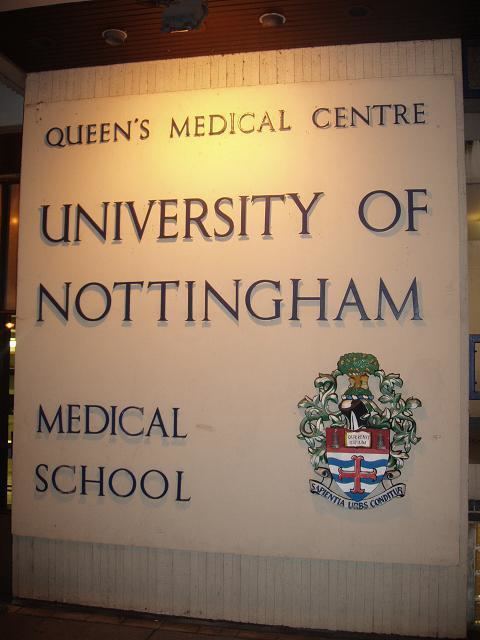Type Medical School Students 330 per year Dean Ian Hall Founded 1970 Dean Ian Hall | Established 1970 Phone +44 115 951 5151 | |
 | ||
Similar University of Nottingham, University of Nottingha, Leicester Medical School, Keele University School of, University of Birmingh | ||
The University of Nottingham Medical School is the medical school of the University of Nottingham, Nottingham, UK. It was the first new medical school to be set up in the 20th century in the country, with the first intake of 48 students graduating in 1975. Student intake has steadily increased to a current level of 330 students per year, including 90 from the satellite graduate-entry school at Derby, which opened in 2003.
Contents
Location
The Medical School is part of the Queen's Medical Centre campus of Nottingham University Hospitals NHS Trust, located to the west of the city centre. It is located in one of four blocks, the other three being the University Hospital. A pedestrian footbridge connects to University Park Campus of the University of Nottingham. Clinical attachments take place on-site in Queen's Medical Centre, as well as Nottingham City Hospital, Derby Hospitals, King's Mill Hospital (Sutton in Ashfield), Lincoln County Hospital and the Pilgrim Hospital (Boston). Placements in general practice and psychiatry occur across Nottinghamshire, Lincolnshire and South Derbyshire. The graduate-entry school is located at the Royal Derby Hospital.
Facilities
The ground floor of the medical school features the lecture theatres, medical library, clinical skills laboratory, student lockers, and a coffee bar. The first floor features seminar rooms, administration and faculty office, a branch of the student's union shop, research areas in neurology and healthcare of the elderly, and access to the University via the footbridge and the hospital main entrance via internal corridors. The third to fifth floors feature practical laboratories, biomedical and community health research facilities, and the anatomy suites. All floors link to the other areas of the hospital.
Course structure
The course at Nottingham is 5 years long, and, unlike all other UK medical schools, includes an intercalated degree as an integral component of the course. As such, all graduates receive a BMedSci degree as well as the BM BS required to graduate as a doctor; at other medical schools, this would require another year of study. The Graduate-Entry course at Derby is 4 years long: the first 1.5 years is based at Derby in a Problem-Based Learning course before the students join the Nottingham course midway through Year 3.
In the traditional course, Years 1 and 2 are mainly lecture-based, with some small-group teaching, practical sessions, and early patient-based contact in GP practices and hospitals. Subjects include anatomy, physiology, biochemistry, pharmacology, behavioural sciences, pathology, neurology, embryology and an introduction to clinical skills. Courses are taught around the body systems and non-lecture sessions aim to build on the lecture content. The first half of Year 3 features a project in one of the Academic Schools, requiring a 10,000 word dissertation and teaching on research methods and statistics. The second half ('Clinical Phase 1') features introductory medicine and surgery. Year 4 (Clinical Phase 2) features the specialities of paediatrics, obstetrics and gynaecology, psychiatry, ophthalmology, ENT (ear, nose and throat), Dermatology, and a 'Special Study Module' of the student's choice. Year 5 (Clinical Phase 3) features Medicine, Surgery, Musculoskeletal Disorders and Disability (Rheumatology and Orthopaedics), General Practice and a Critical Illness Module. Final exams are in late February followed by a 9-week Elective period, that is usually taken abroad. Following this is a short Preparation course for becoming a pre-registration house officer that includes 2 weeks shadowing the current doctor.
Research
Research takes place in the following academic schools of the Faculty of Medicine and Health Sciences. Lecturers are part of one of the schools, and students can spend time in a particular school during the research project (3rd year).
Student life
Most students live in Halls of Residence in the first year and therefore participate in the usual student life of the university, including hall and students' union events on campus and in the city centre. The Medical Society (Medsoc) is its own Student's Union for medical students. It consists of many sub-societies and clubs, and together organises events for all years, including parties, performances, guest lectures and balls. The Medics branch of the University's rag organisation, Karnival, is one of the most successful, and organises events such as the Bed Push, a yearly event in late October where students dress in scrubs and white coats and push hospital beds from the QMC into Old Market Square in Nottingham city centre, stopping motorists and pedestrians on the way and collecting money for charity.
There are numerous medical school societies, including sports clubs, music and drama groups, and academic organisations such as SCRUBS Surgical Society. The Nottingham branch of Medsin supports a range of student charities - two of these, Marrow (supporting the Anthony Nolan Trust by encouraging students to join the UK bone marrow register) and the Kenyan Orphan Project (supporting several ventures in Kisumu, Kenya) have since spread to other universities in the UK.
Graduates
Nottingham graduates can apply to work in either the Trent Deanery, based in local hospitals, or any other deanery across the UK, under the first part of the Modernising Medical Careers programme of postgraduate medical training.
